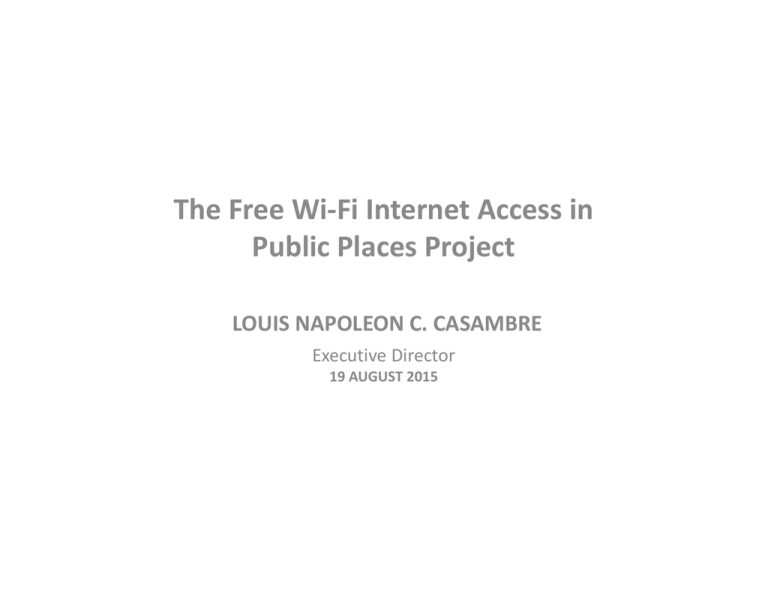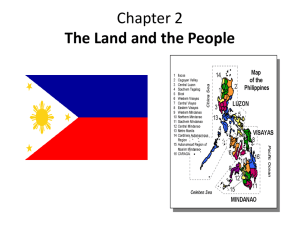The Free Wi‐Fi Internet Access in Public Places Project LOUIS NAPOLEON C. CASAMBRE Executive Director

The Free Wi‐Fi Internet Access in Public Places Project
LOUIS NAPOLEON C. CASAMBRE
Executive Director
19 AUGUST 2015
Project Background
Ownership and usage of mobile phones is high at over 100% penetration rate; Is the “Texting Capital of the World”; Is the “Social Media Capital of the World”; Fastest growing internet population in the World with penetration raising to 52% in 2013; Mobile in the primary device for accessing the Internet, reaching 62% of total subscribers in Q3 2014; 3G/4G speed mobile broadband penetration at 37% Smart phone adoptions is at 54% and connections growth of 75% YoY; Strong competitive IT/BPO sector Source: GSMA Intelligence; Phil. Star 03/28/15
Project Background Philippine ICT Strategic Direction 2010‐2016
Firstly, the PDS sets the development of e‐Government as a priority, facilitating greater efficiencies and effectiveness in the delivery of basic social services and minimizing opportunities for corruption. The PDS calls for implementation of systems which will support the government’s fight against poverty and ensure integration and interoperability of ICT infrastructure and programs across government agencies Another element of the PDS is the focus on supporting continued growth of the IT/BPO industry and extending the benefits outside Metro Manila and Metro Cebu, so as to fast‐track national development and provide opportunities for investment and jobs to other regions in the country.
The social & economic incentive to expand mobile and innovative solutions into under/un‐served communities is now a key focus
Project Background The Free Wi‐Fi Internet Access in Public Places Project
In line with “Internet for all” thrust identified in Philippine Digital Strategy 2011‐2016 Internet Opportunities for All People incorporates the development of the needed infrastructure to overcome the connectivity deficit in the Philippines and increase broadband coverage and penetration. But the PDS also goes beyond infrastructure and emphasizes that the purpose is digital inclusion, and capacity building (i.e. digital literacy) thus looking at the demand side of broadband, affordability issues and services, content and applications available through this infrastructure Broadband Internet access and integration of ICT in curriculum across all levels of our education system will be a priority to ensure that the shortfall of a skilled workforce will be addressed
Project Objectives
Project aims to accelerate government’s efforts in enhancing Internet accessibility for Filipinos; among the thrusts identified in Philippine Digital Strategy 2011‐2016; It will focus on creating an enabling environment: with incentives and a broadband policy that will accelerate the expansion and service provision of broadband by the private sector, reaching previously un‐served areas and customers This project shall give appropriate consideration and attention to avoid undermining existing services, particularly in the served areas, thru policy and technical parameters. In served areas, this public service shall aim to provide a lower entry barrier for users, as well as, improving accessibility Un‐franchised site connectivity providers shall be allowed to offer commercial services using the natural franchise of the government through the DOST ICT Office. The ultimate goal of seeing franchised commercial ICT services in all areas, as mandated
Service Provision User Access
The Free WIFI is a public service , envisioned to provide ubiquitous connectivity to the Internet in the Philippines; Policy Consideration: The public service shall generally be accessible 24/7; All Filipinos and visitors to the country will be the target users;
Service Provision User Access
Policy Consideration: Implement a multi‐level registration system as follows: Level 1 ‐ only requires the machine ID (MAC address) of a device for a user to gain access Level 2 ‐ through the web; a user registers & presents a Philippine government issued ID, or a valid passport Level 3 ‐ where a user will be issued a Citizen’s Digital ID subject to the requirements of the National Public Key Infrastructure that will be used to gain access to the public service and to e‐ Government services.
Service Provision
Policy Consideration: A data volume based Fair Usage Policy shall also be implemented to promote an equitable distribution of the public service. A Fair Usage Policy (FUP) Imposing limits on the user’s amount of data transferred on a duration basis The FUP shall correspond with each user’s registration level.
Service Provision Adherence to Public Policy
The Free Wi‐Fi public service shall not be used for purposes that would be counter to public policy. This shall be implemented by restricting/specifying the services made available.
Policy Consideration: Users will agree to a set of Terms and Conditions upon first login.
Create & update local content at the Captive Portal Setting‐up or procuring the Whitelist; Setting‐up; procuring; updating the Blacklist
Level Registration 3 2 1 Gov’t Digital Certificate Gov’t ID / Passport Device ID
Service Provision
Ports Allowed Content Any Restricted to commonly used ports Any except those in a Blacklist of sites found inconsistent with public policy.
Only from sites in a Whitelist, which would include news, education, government and social networking websites, selected public e‐mail systems.
Project Scope Service Coverage
Consistent with the mandate of the DOST ICT Office, the Government shall extend the coverage for broadband Internet connectivity, especially in underserved and un‐served areas Policy Consideration: On full deployment, the network would serve 105,000 concurrent users Establish WIFI Points of Presence (PoPs) or distribution points: NOC; Centers of Government; DOST & Field Operation Offices & Provincial Offices; Major cities Establish priorities on Service Coverage: Achieve for universal accessibility and utility and interoperability
Project Scope WI‐FI Distribution Points
14 Points‐of‐Presence (PoPs) shall be established at strategic locations of the Country including at identified centers of government where large numbers of public offices would be found: Tuguegarao, Cagayan Dagupan, La Union Tacloban City, Leyte Mabalacat, Pampanga Legazpi City, Albay Puerto Princesa City, Palawan Iloilo City, Iloilo Batangas City, Batangas Calbayog City, Samar Pagadian City, ARMM Zamboanga City, Zamboanga
Major Cities & Surroundings:
Metro Manila, Metro Cebu, Metro Davao
Project Scope Service Coverage
31 sites in Metro Manila, Cebu and Davao, as well sites at other cities that will serve as distribution points or Points of Presence shall also be included. City of Las Piñas City of Makati City of Muntinlupa City of Parañaque Pasay City Taguig City City of Mandaluyong City of Marikina City of Pasig City of San Juan Quezon City Caloocan City City of Malabon City of Valenzuela City of Navotas City of Manila Davao City Cebu City City of Tagum City of Mati City of Digos City of Panabo Island Garden City of Samal City of Naga Lapu‐Lapu City (Opon) Mandaue City Talisay City City of Bogo Toledo City City of Carcar Danao City
Service Coverage Project Scope
In addition, 967 Municipality PoPs in Class 3, 4, 5 and 6 municipalities shall now also be covered. The Project will cover selected public spaces at:
Site Type
AIR HSP LGU LIB PHS PLZ RHU SEA SUC TRN
Grand Total Count of BENEFICIARY SITE
10 200 731 302 3258 64 z1244 21 125 15
5970
Airport Hospital Local Govt Unit Library Primary High School Plaza Rural Health Unit Seaport State Universities and Colleges Train Stations
Region, Province ARMM
Basilan Lanao Del Sur Maguindanao Sulu Tawi‐Tawi
CAR
Abra Apayao Benguet Davao Oriental Ifugao Kalinga Mountain Province
I
Ilocos Norte Ilocos Sur La Union
II
Pangasinan Batanes Cagayan Isabela Nueva Vizcaya Quirino
III
Aurora Bataan Bulacan Nueva Ecija Pampanga Tarlac Zambales
Count of BENEFICIARY SITE 186
13 91 31 36 15
272
60
405
82 101 59 26 39 1 57 30 70 152
240
14 104 86 26 10
253
33 21 6 64 69 31 29
Project Scope IV‐A Region, Province
Batangas Cavite Laguna Quezon Rizal
IV‐B
Marinduque Occidental Mindoro Oriental Mindoro Palawan Romblon
IX
Zamboanga Del Norte Zamboanga Del Sur Zamboanga Sibugay
NCR
First District Fourth District Second District
V
Third District Albay Camarines Norte Camarines Sur Catanduanes Masbate Sorsogon
VI
Aklan Antique Capiz Guimaras Iloilo Negros Occidental
Count of BENEFICIARY SITE 364
97 42 88 124 13
251
35 46 44 57 69
465
101 70 71 24 166 33
416
107 231 78
540
75 167 187 111
484
65 45 137 49 105 83
Region, Province VII
Bohol Cebu Leyte Negros Oriental Siquijor
VIII
Biliran Eastern Samar Leyte Northern Samar Samar (Western Samar) Southern Leyte
X
Bukidnon Camiguin Lanao Del Norte Misamis Occidental Misamis Oriental
XI
Compostela Valley Davao Del Norte Davao Del Sur Davao Oriental Iloilo
XII
North Cotabato South Cotabato Sultan Kudarat
XIII
Agusan Del Norte Agusan Del Sur Dinagat Islands Surigao Del Norte Surigao Del Sur
Grand Total Count of BENEFICIARY SITE 715
236 380 1 70 28
574
23 85 169 98 122 77
254
19 24 63 66 82
216
11 44 122 38 1
47
10 21 16
288
100 6 36 89 57
5970
• • • • • •
Implementation Model
Funding Source:
from the General Appropriation Act of 2015; 1.408 billion 2015 GAA budget allocated; Capital Outlay is only for Php. 20M, the rest is MOOE. in its first year. Leveraging Managed Services: Use of Managed Services sourced as service subscriptions from the private sector shall be the primary means of implementing this Project – Procurement of Goods Contract Type is simple & transparent .
Overall Architecture
: WIFI Network; National PKI; PHOpenIX; TVWS, VSAT; Capture Portal Services; Satellite Broadcast services;
Public Sector Participation
– – – – National Social Marketing Campaign Beneficiary sites will be engaged through a Memorandum of Understanding; LGUs shall mainly provide “front desk” services that would include social marketing, and administrative assistance (custodianship); A Project Management Team (PMT) attached to DOST‐ICTO
Registration Authorities (RA)
in implementing; Each LGU shall be enrolled to serve as a Registration Authority Public‐Private‐Partnerships shall also be considered
Implementation Model: Leveraging Managed Services
Scope of Managed Services:
Use of managed services shall by default reuse existing private sector infrastructure Connectivity Services – Links are classified as ‐ 1. International IP Transport Services: bandwidth between the project’s IP Core and the Internet bandwidth 2. Domestic IP Transport Services: bandwidth to a PoP 3. Municipal IP Transport Services: bandwidth between a PoP and a city or municipal center; connect MPoP to one or more PoPs at a specified bandwidth; commonly called the “Middle Mile”.
4. Last Mile & Rural Mile IP Transport Services: bandwidth from a city or municipal center (i.e. from a PoP or mPoP) to a site within the area served by local connectivity providers; The Rural Mile links would be those to a site in an underserved or un‐served area System Integration Service ‐ Nodes 5. System Management & Access Service
WIFI NETWORK OVERVIEW
Hotspots in served areas
Point of Presence (PoPs)
Last mile provider connections from sites to PoPs Internet Long haul (backbone) > 1 Gbps CIR International Transit PH OpenIX
Hotspots in underserved & unserved areas via TV White Space Technologies
Gov't Data Centers Content Distribution Caches 4 n 6 PUBLIC PRIVATE Up to 12 km across water, over hills, through forests and walls
Implementation Model
Leveraging Managed Services Partitioned into Level Playing Fields; Independence of the Nodes and Links SLAs enforcement services shall be procured separately Will not compete with existing commercial services Service Provider’s equipment, using DOST ICT Office resources, to be used for other purposes than for the Project, shall not be allowed unless explicitly included as part of the contracts. Non‐franchise holders are allowed to participate
Implementation Model
Leveraging Managed Services Use of managed services shall by default reuse existing private sector infrastructure. This will maximize the use of the existing ICT infrastructure investments of the country; thus implementable by local industry Reuse of the shared services provisioned under the Integrated Government Philippines (iGovPhil) project, the PH OpenIX, and the PREGINET projects shall be mandatory Use of other existing public sector assets such as the DOST ICT Office outside plant facilities (e.g. poles, copper or fiber optic cables), telecommunication towers and other facilities, shall likewise be pursued, however on AS‐IS basis. With direct government intervention, the Project will pursue public‐private‐ partnerships and expects Commercial Services will be offered by the Private Sector/ provider in the un‐served areas; along side those provided for the project using the same infrastructure and through the shared use of the Wi‐ Fi access points;
Implementation Model
Leveraging Managed Services The service subscriptions shall be on a 12‐month basis; Payment will always be for services rendered hence payment will begin 30‐days after a service is installed All One‐Time‐Charges should be embedded in the monthly subscription costs After the 12 th month of service, a subscription will be evaluated for possible renewal
Steering Committee
The project shall convene the Steering Committee to formulate general policy and coordinate interventions amongst its members and their various stakeholders
Advisory Committee
To ensure project’s effectiveness and feasibility; composed of various non‐government stakeholders, including industry and civil society
Project Management
The DOST ICT Office shall be responsible for providing beneficiaries with technical and administrative support, and capacity building, and shall also perform 2nd level and 3rd level user support once its personnel have been properly trained.
Steering Committee
Cooperation with the Steering Committee shall be with Area Project Directors
Roles and Relationship of the Committees
1) End‐User related End user terms and conditions Fair usage policy Portal Content Localization 2) Technical implementation Issuance and use of digital certificate to access free Wi‐Fi Blacklist Whitelist PH OpenIX 3) General implementation Deployment of free Wi‐Fi Accreditation of private entities as Registration Authority Government agencies to extend free Wi‐Fi service after office hour
Areas of Cooperation
The DOST ICT Office shall be the lead agency responsible for the overall planning, implementation and management of the Project, and ensuring compliance to the guidelines and directives given by the Steering Committee Training for the LGUs shall be provided in partnership with the Field Operations Office of the ICT Office or a contracted private sector provider, as necessary User support shall be provided by the private sector providers and the DOST ICT Office.
The use of Future Technology “TV White Space” shall be advocated by the DOST ICT Office in providing WiFi connectivity; for which technical assistance and support may be provided
Areas of Cooperation
By way of a MOU, fiscal incentive with the Service Provider, the Local Government Units (LGUs) with un‐served or underserved areas shall be enjoined to distribute this Free WiFi public service by provisioning connectivity to those areas. It will be entirely up to the LGUs and/or their providers to decide what technologies to use :
Area Project Director
In order to expedite implementation of the “Free Wi‐Fi Internet Access in Public Places”, agencies from the government and LGUs where the Wi‐Fi Internet access are located shall extend cooperation and assistance, including
the reasonable use of electricity and facilities for the purpose and ensure the security of the equipment: FOO Director
Areas of Cooperation
The LGUs shall mainly provide “front desk” services that would include social marketing, and administrative assistance; The campaign efforts shall be in coordination with the LGU LGUs will also be responsible for configuring the location specific content of the Capture Web Portal



